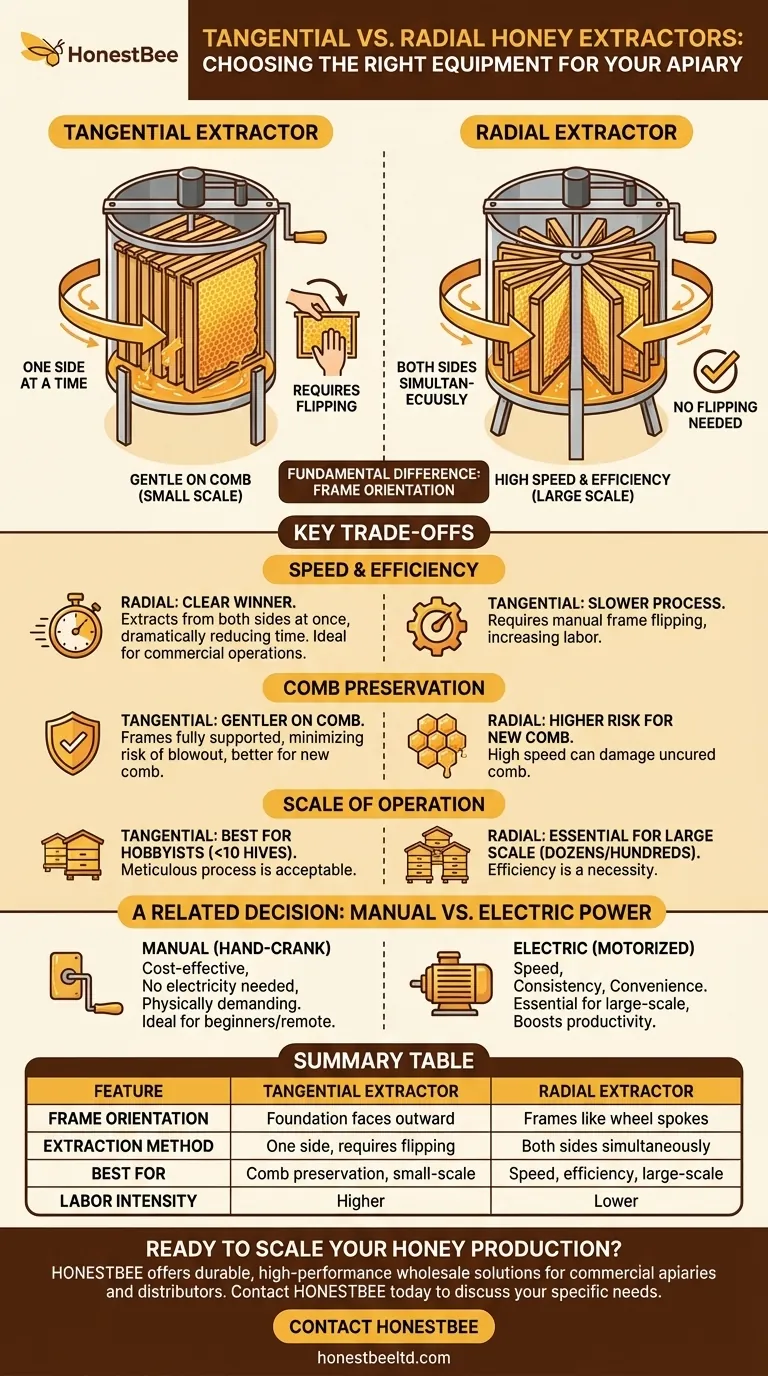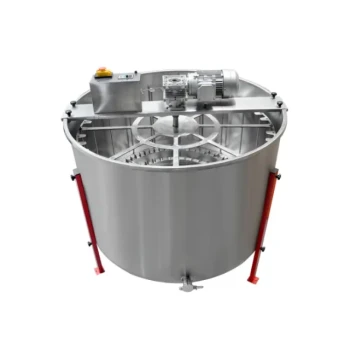The fundamental difference between tangential and radial honey extractors lies in how they orient the frames for spinning. A tangential extractor holds the honeycomb foundation facing outward, extracting honey from only one side at a time. In contrast, a radial extractor positions frames like spokes on a wheel with the top bar facing out, allowing centrifugal force to pull honey from both sides simultaneously.
Your choice between these two designs is a direct trade-off between speed and comb preservation. Radial extractors are built for high-speed efficiency, while tangential extractors offer a gentler process that better protects the delicate wax comb.

How Each Extractor Works: A Mechanical Comparison
Understanding the mechanics of each design reveals its inherent strengths and weaknesses. The orientation of the frame inside the drum dictates the entire extraction process.
The Tangential Method: One Side at a Time
In a tangential extractor, the frames are placed in a cage with the flat side of the honeycomb facing the outer wall of the drum.
When spun, honey is extracted from this outward-facing side only. To complete the job, the beekeeper must stop the machine, manually flip each frame, and then spin them again to extract honey from the second side.
The Radial Method: Spokes on a Wheel
A radial extractor holds frames vertically, with the top bar facing the outer wall and the bottom bar pointing toward the center post. This alignment resembles the spokes of a wheel.
Because of this orientation, centrifugal force acts equally on both sides of the comb at once, pulling honey out from both cells simultaneously. This design eliminates the need to flip frames, making the process much faster.
Understanding the Key Trade-offs
Neither design is universally superior; the right choice depends entirely on your operational scale and priorities.
Speed and Efficiency
Radial extractors are the clear winner for speed and efficiency. By extracting from both sides at once and removing the manual step of flipping frames, they dramatically reduce the time and labor required for a harvest.
This makes them the preferred choice for commercial beekeepers or anyone with a large number of hives.
Comb Preservation
Tangential extractors are gentler on the comb. The frame's foundation is fully supported by the extractor's cage or mesh during spinning.
This support minimizes the risk of the comb "blowing out" or being damaged, which is a common concern with new, uncured comb in high-speed radial extractors. Preserving comb saves the bees immense time and energy, as they don't have to rebuild it.
Scale of Operation
Your number of hives is a major factor. A hobbyist with fewer than 10 hives may find the slower, more meticulous process of a tangential extractor perfectly acceptable.
However, a beekeeper managing dozens or hundreds of hives will find the efficiency of a radial extractor to be an operational necessity.
A Related Decision: Manual vs. Electric Power
Beyond the extractor type, you must also choose between a manual hand-crank or an electric motor. This decision is closely tied to your scale and budget.
The Manual (Hand-Crank) Option
Manual extractors are cost-effective, simple, and require no electricity, making them ideal for use in remote apiaries.
They are an excellent entry point for beginners and small-scale beekeepers, but the process is physically demanding and significantly slower.
The Electric (Motorized) Option
Electric extractors offer speed, consistency, and convenience with minimal manual effort. They are more expensive but are considered an essential tool for large-scale production.
The ability to set a speed and walk away boosts productivity and maximizes yield, making them a worthwhile investment for serious beekeepers.
Making the Right Choice for Your Apiary
Select your equipment based on a clear understanding of your goals, budget, and the size of your operation.
- If your primary focus is preserving delicate comb and you have few hives: A tangential extractor is the safer, more meticulous choice.
- If your primary focus is processing a large harvest quickly and efficiently: A radial extractor is the industry standard for speed and reduced labor.
- If you are a beginner on a tight budget with just a few hives: A manual (hand-crank) tangential extractor offers the lowest barrier to entry.
- If you are scaling up your operation and value your time: An electric radial extractor is a powerful investment that will pay dividends in productivity.
Understanding these core designs empowers you to select the tool that best aligns with your beekeeping philosophy and operational scale.
Summary Table:
| Feature | Tangential Extractor | Radial Extractor |
|---|---|---|
| Frame Orientation | Foundation faces outward | Frames positioned like wheel spokes |
| Extraction Method | One side at a time, requires flipping | Both sides simultaneously |
| Best For | Comb preservation, small-scale operations | Speed and efficiency, large-scale operations |
| Labor Intensity | Higher (manual flipping required) | Lower (no flipping needed) |
Ready to Scale Your Honey Production?
Whether you're a commercial apiary prioritizing speed with a radial extractor or a distributor seeking equipment that protects delicate comb, HONESTBEE has the wholesale solution for you. We supply durable, high-performance beekeeping equipment designed to maximize your harvest efficiency and honey quality.
Contact HONESTBEE today to discuss your specific needs and discover how our extractors can boost your operation's productivity.
Visual Guide

Related Products
- HONESTBEE 72 Frame Industrial Electric Honey Extractor for Beekeeping
- 6 Frame Manual Stainless Steel Honey Extractor Beekeeping Equipment
- HONESTBEE 6 Frame Three Use Electric Honey Extractor for Beekeeping
- 24 Frame Honey Extractor Commercial Radial Honey Frame Extraction Machine
- 8-Frame Electric Self-Reversing Honey Extractor Spinner for Commercial Honey Extraction Equipment
People Also Ask
- What should a beekeeper do after extracting honey from supers? A Guide to Harvest Management
- How is honey harvested from Langstroth hives? A Guide to Efficient, Comb-Preserving Extraction
- Why is preserving honeycomb integrity important, and how do automated extractors help? Boost Hive Health & Honey Yields
- Can a manual extractor be upgraded to an electric one? Save Labor & Boost Efficiency
- What is the energy consumption like for automatic honey extractors? Maximize Your Harvest Efficiency



















